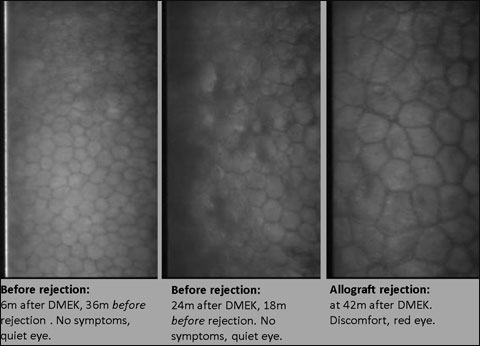Allograft rejection may be predicted in endothelial keratoplasty
Monitoring endothelial cell morphology may help diagnose imminent allograft rejection before it becomes clinically manifest.
Allograft rejection is one of the most serious complications in corneal transplantation, often resulting in graft failure. Among the advantages of lamellar keratoplasty is a reduction in rejection rates, from 15% to 30% in penetrating keratoplasty to 5% to 12% in Descemet’s stripping automated endothelial keratoplasty and a further reduction to 1% to 5% in Descemet’s membrane endothelial keratoplasty. These decreasing rates have been suggested to be attributed to the continuous reduction in graft thickness, with a concomitant lower antigen load, along with the refinement of endothelial keratoplasty techniques.
Signs, symptoms of rejection
Allograft rejection is normally diagnosed by the presence of objective clinical signs, such as keratoprecipitates, a Khodadoust line, anterior uveitis and corneal edema, as well as subjective patient complaints, such as red eye, photophobia, ocular pain, decrease in visual acuity and general ocular discomfort. Although rejection episodes can often be controlled by intensified steroid treatment, the damage to the endothelium may have been done, possibly leading to secondary graft failure and necessitating repeat keratoplasty.

In other words, a rejection episode is recognized by clinical symptoms only after damage to the transplant has potentially been done. Therefore, early detection of allograft rejection before its clinical manifestation would be highly beneficial in the management of allograft rejection and the prolongation of graft survival. For this reason, the Netherlands Institute for Innovative Ocular Surgery set out to develop a method that can identify rejection before a clinical immune response has developed. By strict monitoring of endothelial cell morphology by specular microscopy and other supporting techniques, imminent allograft rejection may now be diagnosed before it becomes clinically manifest.
Retrospective study
In a retrospective analysis of 500 eyes that underwent DMEK surgery, with a mean follow-up of 34 ± 18 months, specular microscopy was performed at standardized time intervals. Interestingly, in the seven eyes that developed allograft rejection at 4 to 42 months after surgery, typical endothelial cell changes could be observed at 1 to 18 months before clinical diagnosis. While the donor endothelium of asymptomatic controls showed hexagonal endothelial cells with homogenous reflectivity, regular patterns and invisible cell nuclei, the endothelium of eyes before manifest allograft rejection showed disorganized cell shapes, different cell sizes and inhomogeneous distribution, as well as high reflectivity and/or pronounced nuclei (Figure).
After intensified steroid treatment, allograft rejection subsided clinically in all eyes while typical endothelial cell changes remained, and two eyes later developed secondary graft failure that required repeat DMEK. The observation that endothelial cell changes were visible well in advance suggests that allograft rejection is not an acute event. The opposite may be true: A gradual deterioration in endothelial cell layer morphology would better agree with a prolonged, slowly “accumulating” process. As such, these early endothelial cell changes may be indicative for imminent allograft rejection.

Image: Gerber-Hollbach N
It should be kept in mind that a change in endothelial cell layer morphology could also result from disease, so endothelial changes are not pathognomic of just allograft rejection. However, whatever cause may behind it, a more frequent screening of post-DMEK eyes would probably be indicated in most cases. If an upcoming rejection is suspected, it could be advocated to intensify steroid therapy, before clinical signs become apparent, to minimize endothelial damage and the need for re-transplantation. A disadvantage of our endothelial screening method is that it requires a well-experienced observer to determine which post-transplant eyes may be “at risk” while avoiding steroid overtreatment at the same time.
- References:
- Anshu A, et al. Ophthalmology. 2012;doi:10.1016/j.ophtha.2011.09.019.
- Dapena I, et al. Cornea. 2011;doi:10.1097/ICO.0b013e31820d8540.
- Guerra FP, et al. Ophthalmology. 2011;doi:10.1016/j.ophtha.2011.06.002.
- Hjortdal J, et al. Cornea. 2013;doi:10.1097/ICO.0b013e3182687ff3.
- Lee WB, et al. Ophthalmology. 2009;doi:10.1016/j.ophtha.2009.06.021.
- Monnereau C, et al. Am J Ophthalmol. 2014;doi:10.1016/j.ajo.2014.05.030.
- Price MO, et al. Br J Ophthalmol. 2009;doi:10.1136/bjo.2008.140038.
- Price MO, et al. Ophthalmology. 2010;doi:10.1016/j.ophtha.2009.07.036.
- For more information:
- Nadine Gerber-Hollbach, MD, PhD, can be reached at the Netherlands Institute for Innovative Ocular Surgery (NIIOS), Laan op Zuid 88, 3071 AA Rotterdam, The Netherlands; email: research@niios.com
Disclosures: Gerber-Hollbach reports no relevant financial disclosures. Melles reports he is a consultant for DORC International/Dutch Ophthalmic USA and SurgiCube International. The other co-authors report no relevant financial disclosures.
